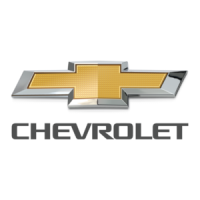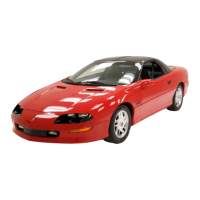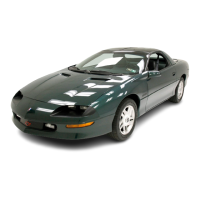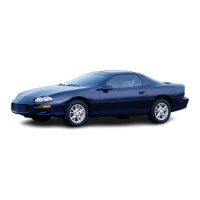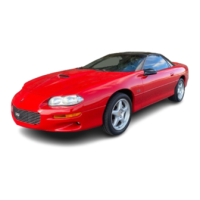
 Loading...
Loading...
Do you have a question about the Chevrolet 1999 Camaro and is the answer not in the manual?
| Brand | Chevrolet |
|---|---|
| Model | 1999 Camaro |
| Category | Automobile |
| Language | English |
Information on adjusting front seats, including manual and power seat operations.
Instructions on adjusting front seatback angle and warnings about reclining while driving.
Guidance on proper safety belt usage and things to avoid, including air bag system explanation.
Explanation of the vehicle's Next Generation frontal air bags and their interaction with safety belts.
Information on ignition and door keys, including bar-coded key tags and key code.
Details on locking and unlocking vehicle doors from inside and outside.
Operation of power door locks, including Last Door Closed Locking feature.
Instructions for using the remote keyless entry transmitter to lock/unlock doors and trunk.
How to open the hatch using the door key or the remote hatch release.
Overview of the instrument panel and its components for vehicle monitoring.
Explanation of various warning lights, gages, and indicators on the instrument panel.
Controls for heating, air conditioning, and ventilation, including fan and air control knobs.
Instructions for using the defogger and rear window defogger to clear windows.
How to use the ventilation system and tips for optimal airflow and defogging.
Introduction to the Delco Electronics audio system and its features.
Operation of the AM-FM stereo, cassette player, including radio and tone controls.
Instructions for playing cassette tapes, including tone and speaker adjustments.
Features of the Monsoon stereo system with CD player and automatic tone control.
How to insert, play, and control compact discs in the CD player.
Information on the THEFTLOCK system for radio security and its activation/disabling.
Key advice for safe driving, emphasizing anticipation and concentration.
Information on the effects of alcohol on driving ability and legal limits.
Explanation of perception and reaction time in braking, and factors affecting stopping distance.
How ABS works to prevent skidding and what the ABS warning light indicates.
Traction control system that limits wheel spin, especially on slippery roads.
Guidance on steering control, power steering, and safe driving techniques on curves.
Understanding and preventing vehicle skids caused by braking, steering, or acceleration.
Tips for safe driving on wet surfaces, including hydroplaning awareness.
Guidance on vehicle weight limits, capacity, and proper loading procedures.
Essential information and safety rules for successfully and safely trailering.
How to use hazard warning flashers to alert others and signal a vehicle problem.
Step-by-step instructions for safely jump starting a vehicle with jumper cables.
Safety guidelines and precautions to follow when towing your vehicle.
Information on engine overheating, protection modes, and what to do.
Identification of major components in the engine cooling system.
Detailed instructions on how to safely change a flat tire using the vehicle's equipment.
Methods for freeing a vehicle stuck in sand, mud, ice, or snow, with caution.
Guidance on using genuine GM parts and trained service personnel for vehicle maintenance.
Information on recommended gasoline octane ratings and fuel quality specifications.
Instructions on how to safely open the fuel filler door and remove/replace the gas cap.
Overview of key components under the hood and safety precautions.
Procedure for checking engine oil level using the dipstick and ensuring accurate readings.
Guidance on selecting the correct engine oil based on viscosity and API certification.
Information on the Oil Life Monitor system and recommended oil change intervals.
When to check and change automatic transmission fluid and filter based on driving conditions.
Procedures for checking transmission fluid level at both hot and cold operating temperatures.
How to check the fluid level in the clutch master cylinder reservoir and identify potential problems.
Information on the radiator cap's function and proper installation to prevent coolant loss.
Details about the DEX-COOL coolant system, its benefits, and maintenance requirements.
Information on the power steering fluid reservoir and when to check the fluid level.
Overview of the brake system, including brake fluid type and reservoir location.
Explanation of the warning sound from worn brake pads and the need for service.
Importance of using genuine GM replacement parts for brake system components.
Guidance on tire maintenance, safety, and the dangers of improper tire usage.
How to set and maintain correct tire inflation pressures for optimal performance and safety.
Procedures for checking tire wear, inspecting for damage, and performing tire rotation.
Indicators that signal the need for new tires, including tread wear and damage.
Advice on selecting new tires, including TPC Spec numbers and tire size considerations.
Explanation of tire grades for treadwear, traction, and temperature performance.
Information on factory alignment and balancing, and when re-adjustment might be needed.
Guidance on replacing bent, cracked, or corroded wheels, and using correct parts.
Warning about the dangers of using used wheels and the recommendation for new GM parts.
Tips for cleaning interior surfaces like vinyl, leather, plastic, and fabric.
Methods for cleaning fabric and carpet, including spot cleaning and odor removal.
Proper techniques for cleaning leather surfaces to maintain their finish.
How to clean the windshield and wiper blades for clear visibility.
Best practices for washing your vehicle to preserve its finish.
Advice on waxing and polishing your vehicle's basecoat/clearcoat paint finish.
Instructions for cleaning and maintaining your convertible top.
Proper methods for cleaning aluminum and chrome-plated wheels.
How to clean your vehicle's tires using a stiff brush and tire cleaner.
Importance of cleaning the underbody to prevent corrosion from road chemicals.
Overview of the vehicle's electrical system, circuit protection, and add-on equipment.
Explanation of how fuses and circuit breakers protect the vehicle's wiring.
Diagram and description of the main fuse block and its fuse assignments.
Identification and usage of fuses located in the underhood electrical center.
List of fuses and their corresponding usage in Fuse and Relay Center 1.
Details on fuses and relays located in the underhood electrical system.
Identification and usage of fuses in Fuse and Relay Center 2.
Table of approximate fluid capacities and engine specifications for various vehicle components.
Details on engine type, VIN code, fuel delivery, valve arrangement, displacement, and firing order.
Information on air conditioning refrigerants and the importance of using the correct type.
List of common replacement parts, their types, and lengths or sizes.
Details on services to be performed at specific mileage intervals for optimal vehicle performance.
Guidance on how to use the maintenance schedule based on driving habits and conditions.
Schedule of maintenance services required at various mileage intervals.
Routine checks and services that owners can perform to maintain vehicle safety and performance.
Essential underhood checks to perform each time you refuel your vehicle.
Procedure for checking the engine oil level and adding oil if necessary.
How to check the engine coolant level and add coolant if needed.
Procedure for checking and refilling the windshield washer fluid reservoir.
Monthly checks including tire inflation and cassette deck cleaning.
Semi-annual checks including restraint systems and wiper blades.
How and when to check the manual transmission fluid level.
How and when to check the automatic transmission fluid level.
Annual checks including key lock cylinders and body lubrication.
Important inspections to be performed by a dealer or qualified service center.
Inspection of steering system, suspension components, and related hoses.
Inspection of the exhaust system for damage, leaks, and connections.
Inspection of hoses, fittings, clamps, radiator, and condenser for proper cooling system operation.
Inspection of brake lines, hoses, pads, rotors, calipers, and parking brake.
List of recommended fluids and lubricants, including part numbers or specifications.
A log to record maintenance dates, odometer readings, and services performed.
Steps to resolve concerns with dealerships and Chevrolet Customer Assistance.
Contact information for deaf, hard of hearing, or speech-impaired customers using TTYs.
Contact information for Chevrolet Customer Assistance Centers in the United States and Canada.
Information on adaptive equipment reimbursement and resource information for disabled individuals.
Details on the free roadside assistance program, including Basic Care and Courtesy Care services.
Information on transportation options provided during warranty repairs.
How to report vehicle safety defects directly to General Motors.
Information on how to order service manuals and owner literature in Canada.

